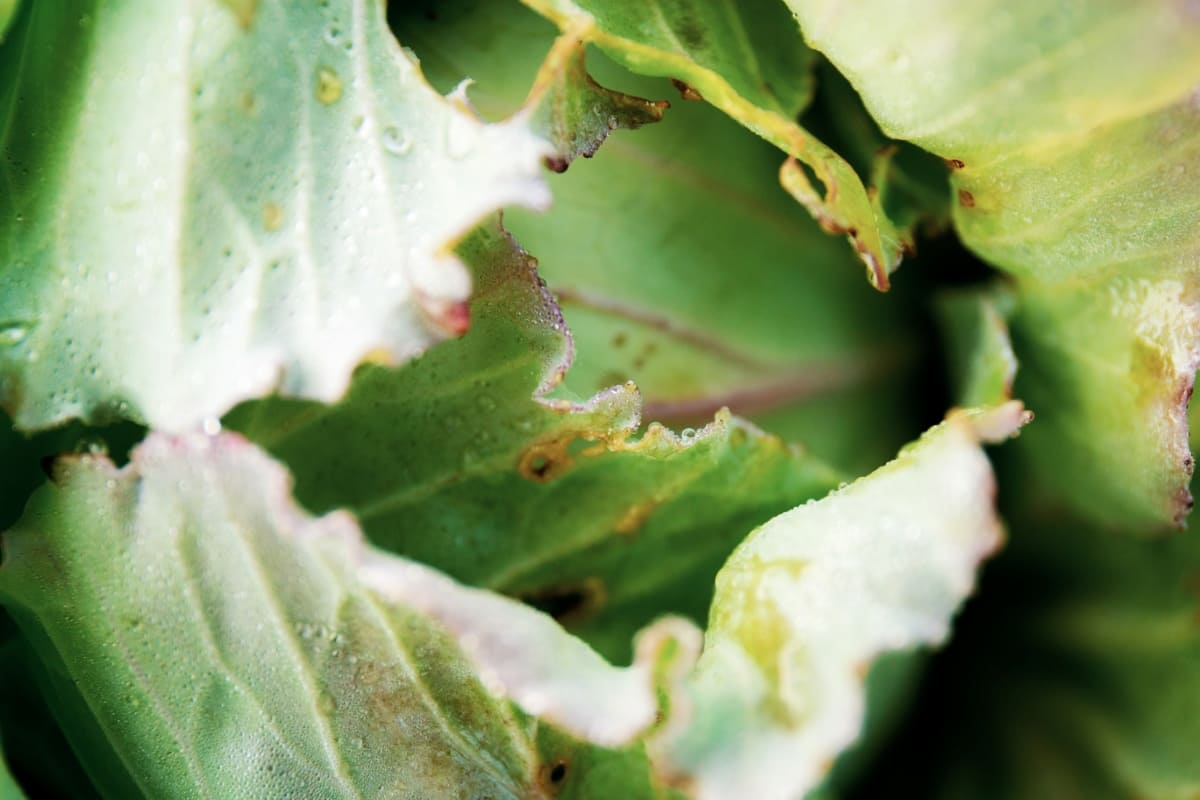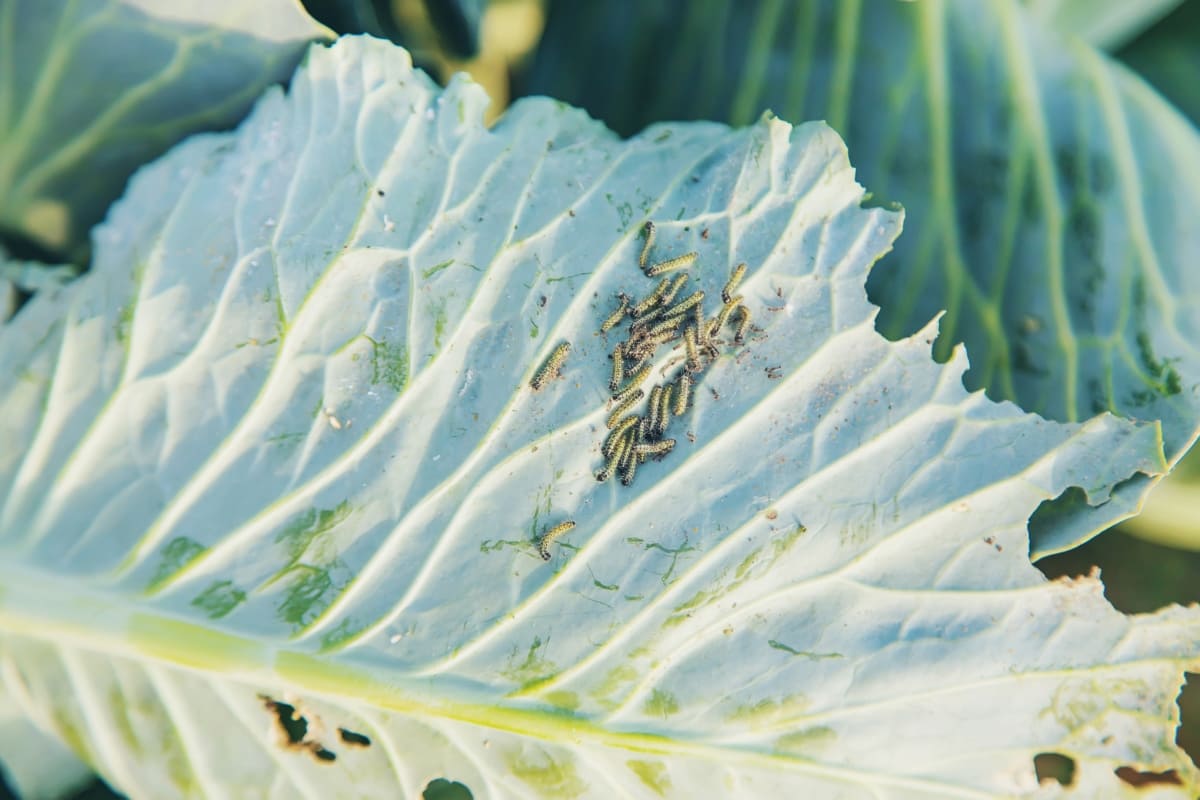Cabbage worms can wreak havoc on your cole crops, leaving unsightly chewed leaves and stunted growth. The term “cabbage worm” is commonly used to refer to four different species of lepidopteran larvae that have a particular fondness for feasting on cabbages and their relatives. One of the most common types of cabbage worms is the imported cabbageworm. These velvety green larvae boast short, fine hairs and faint yellow stripes along their sides and backs.

How to Get Rid of Cabbage Worms with Baking Soda
Understanding Cabbage Worms: Identification and Lifecycle
Cabbage worms, those sneaky little pests that wreak havoc on our beloved cole crops, can be quite a nuisance. It’s important to understand their identification and lifecycle to combat them effectively. The imported cabbageworm is one common type of cabbageworm. These velvety green larvae measure about 1-1/4 inch long. They have short, fine hairs covering their bodies and faint yellow stripes down their sides and backs.
You can easily spot the five sets of pro-legs on these critters. Knowing the complete life cycle of cabbage worms is crucial in devising an effective control strategy. The duration of their life cycle ranges from three to six weeks, depending on weather conditions. It starts with adult butterflies laying eggs on the undersides of leaves. Once hatched, the larvae feed voraciously on cabbage plants until maturity.
The Benefits of Using Baking Soda to Control Cabbage Worms
Baking soda is a versatile home ingredient that can effectively control cabbage worms. One of the major benefits of using baking soda is its ability to disrupt the feeding habits and digestion of these pests. Applying water and baking soda to plants creates a protective barrier that repels cabbage worms. Another advantage of using baking soda to control Cabbage worms is its availability and affordability.
In case you missed it: Benefits of Baking Soda for Houseplants

Unlike chemical pesticides, which can be expensive and harmful to the environment, baking soda offers a cost-effective and eco-friendly solution. Also, it has been found to have antifungal properties that can help prevent fungal diseases commonly associated with cabbage plantations. This dual-action benefit makes it an excellent choice for gardeners looking for natural alternatives to protect their crops from pest infestations and fungal infections.
Neem Oil: A Natural Solution for Cabbage Worm Infestations
Neem oil is a powerful and natural solution for combating cabbage worm infestations in your garden. This organic remedy has been used for centuries to control pests and protect plants. The strong scent of neem oil is a deterrent for cabbage worms, making them less likely to lay their eggs on your beloved brassicas. Additionally, it disrupts their feeding behavior by inhibiting their ability to digest food properly.
Creating a Homemade Spray to Eliminate Cabbage Worms
One such solution is creating your homemade spray to repel and eliminate Cabbage Worms from your beloved cole crops. To make this homemade spray, you’ll need three key components: water, dish soap, and garlic. Start by filling water in a spray bottle, leaving enough space for the other ingredients at the top. After that, add a few drops of dish soap into the bottle – this will help suffocate and kill any cabbage worm larvae on contact.
Before using your homemade spray on your plants, always test it on a small area first to ensure no adverse effects. You can create an effective homemade spray that combats cabbage worms without harsh chemicals using simple household ingredients like dish soap and garlic combined with water as an organic base.
Harnessing the Power of Vinegar to Repel Cabbage Worms
Vinegar is not just a versatile ingredient in the kitchen; it can also be an effective tool for repelling cabbage worms. The strong odor of vinegar is a deterrent for cabbage worms, making them less likely to lay their eggs on your plants. Mix vinegar and water equally in a spray bottle to harness its power.
Make sure to cover the tops and undersides of the leaves, as this is where these sneaky insects like to hide. Reapply every few days or after rainfall to maintain its effectiveness. Aside from repelling cabbage worms, vinegar also has antifungal properties that can help protect your crops from diseases. Always test on a small area first before applying it more broadly.
Using Dish Soap as an Effective Treatment for Cabbage Worms
Using dish soap as an effective treatment for cabbage worms is a simple and natural solution that can help keep your cole crops healthy and pest-free. The soapy water coats the worms and prevents them from feeding on your precious vegetables. It’s important to cover all surfaces thoroughly, including both sides of the leaves where these pests tend to hide. By regularly using dish soap as a treatment for cabbage worms, you can effectively control their population without resorting to harsh chemicals that may harm beneficial insects in your garden.
Step-By-Step Guide: How To Get Rid of Cabbage Worms with Baking Soda
- Prepare the Baking Soda Mixture – To start, you’ll need to create a simple baking soda mixture that will help eliminate cabbage worms. Combine one tablespoon baking soda in a small bowl with one quart of water. Stir well until the baking soda is fully dissolved.
- Apply the Mixture to Your Plants – Carefully pour the mixture of baking soda into a spray bottle. Make sure to shake it well before each use. Once your spray bottle is ready, apply the solution directly onto your cabbage plants.
- Coat Both Sides of Leaves – When spraying your plants, thoroughly coat both sides of the leaves. This will ensure that any existing cabbage worms or their eggs are effectively targeted and eliminated.
- Repeat as Needed – To maintain control over cabbage worm infestations, it’s important to repeat this process regularly. Aim for once every week or two, depending on how severe the problem is in your garden.
In case you missed it: Homemade DIY Baking Soda Solution for Pests and Disease Control: Recipe for Natural and Organic Benefits of Plants

Step-By-Step Guide: Using Neem Oil to Combat Cabbage Worm Infestations
- It is a natural and effective solution for combating cabbage worm infestations. Not only does it help to eliminate these pesky pests, but it also acts as a deterrent, preventing future infestations.
- To begin, gather your supplies. You will need neem oil, water, and a spray bottle. Mix neem oil (about one tablespoon) in the spray bottle with one quart of water.
- Next, identify where cabbage worms are present or likely to be found. Pay close attention to the undersides of leaves and near the base of plants. Using gentle sweeping motions, evenly coat the affected areas with the neem oil mixture. Be sure to cover both sides of each leaf and any surrounding foliage.
- Repeat this process every seven to ten days until you see no signs of cabbageworm activity. It’s important to be consistent in your application for optimal results. However, testing a small area before treating your entire garden is always a good idea.
DIY Recipe: Homemade Spray for Controlling Cabbage Worms
You’ll need a few key ingredients: garlic cloves, onion bulbs, cayenne pepper powder, liquid soap (preferably organic), and water. These common household items are readily available and natural deterrents for those pesky cabbage worms. Combine several garlic cloves and onion bulbs into a fine paste. The strong aroma of these vegetables will act as a repellent against the cabbage worms. Add one tablespoon of cayenne pepper powder to the mixture. This additional space will further enhance its effectiveness in warding off these unwanted pests.
Next comes the liquid soap, an essential ingredient that helps the spray adhere to leaves and larvae. Add two tablespoons of liquid soap to one liter of water and mix thoroughly until well combined. Now that your homemade spray is ready, it’s time to implement it. Using a sprayer bottle or pump sprayer, apply the solution generously onto both sides of the cabbage leaves where you’ve spotted worm activity or infestation. To create your homemade vinegar and dish soap spray to control cabbage worms, follow these simple steps;
- In a spray bottle, combine one-part white vinegar with three parts of water.
- Add a few liquid dish soap drops to the mixture.
- Shake well to ensure all elements are thoroughly mixed.
In case you missed it: How to Pollinate Cabbage Flowers: Hand Pollination, Natural Pollination Methods, and Tips

Apply the solution directly onto affected plants, focusing on both sides of the leaves where the larvae tend to hide. Remember to reapply after rainfall or heavy watering since this natural remedy may wash away over time. It’s also important not to oversaturate your plants with this mixture, as it may cause harm if used excessively.
Conclusion
These cabbage worms come in various forms but are most easily recognized by their velvety green appearance. You may also notice their five pro-leg sets, which help them move around. Understanding the lifecycle of these pests is crucial in controlling them effectively. The complete life cycle of the cabbage worm takes about three to six weeks, depending on weather conditions.
- Feed Your Flock for Less: Top 10 Tips to Save on Chicken Feed
- Ultimate Guide to Ossabaw Island Hog: Breeding, Raising, Diet, and Care
- Hatching Answers: The Top 10 Reasons Your Chickens Aren’t Laying Eggs
- Eggs and Economics: Breaking Down the Cost of Raising Backyard Chickens
- Defend Your Greens: Proven Methods to Keep Iguanas Out of Your Garden
- Ultimate Guide to Cinnamon Queen Chicken: A Comprehensive Guide for Beginners
- Ultimate Guide to California Tan Chicken: Breeding, Raising, Diet, Egg-Production and Care
- Ultimate Guide to Marsh Daisy Chicken: Breeding, Raising, Diet, and Care
- 10 Types of Chicken Farming Businesses You Can Start for Profits